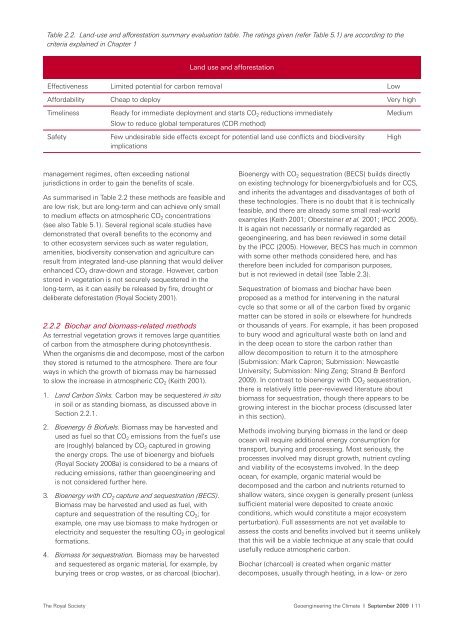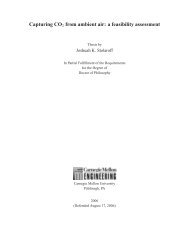Royal Society - David Keith
Royal Society - David Keith
Royal Society - David Keith
Create successful ePaper yourself
Turn your PDF publications into a flip-book with our unique Google optimized e-Paper software.
Table 2.2. Land-use and afforestation summary evaluation table. The ratings given (refer Table 5.1) are according to the<br />
criteria explained in Chapter 1<br />
Land use and afforestation<br />
Effectiveness Limited potential for carbon removal Low<br />
Affordability Cheap to deploy Very high<br />
Timeliness<br />
Safety<br />
Ready for immediate deployment and starts CO 2 reductions immediately<br />
Slow to reduce global temperatures (CDR method)<br />
Few undesirable side effects except for potential land use conflicts and biodiversity<br />
implications<br />
Medium<br />
High<br />
management regimes, often exceeding national<br />
jurisdictions in order to gain the benefits of scale.<br />
As summarised in Table 2.2 these methods are feasible and<br />
are low risk, but are long-term and can achieve only small<br />
to medium effects on atmospheric CO 2 concentrations<br />
(see also Table 5.1). Several regional scale studies have<br />
demonstrated that overall benefits to the economy and<br />
to other ecosystem services such as water regulation,<br />
amenities, biodiversity conservation and agriculture can<br />
result from integrated land-use planning that would deliver<br />
enhanced CO 2 draw-down and storage. However, carbon<br />
stored in vegetation is not securely sequestered in the<br />
long-term, as it can easily be released by fire, drought or<br />
deliberate deforestation (<strong>Royal</strong> <strong>Society</strong> 2001).<br />
2.2.2 Biochar and biomass-related methods<br />
As terrestrial vegetation grows it removes large quantities<br />
of carbon from the atmosphere during photosynthesis.<br />
When the organisms die and decompose, most of the carbon<br />
they stored is returned to the atmosphere. There are four<br />
ways in which the growth of biomass may be harnessed<br />
to slow the increase in atmospheric CO 2 (<strong>Keith</strong> 2001).<br />
1. Land Carbon Sinks. Carbon may be sequestered in situ<br />
in soil or as standing biomass, as discussed above in<br />
Section 2.2.1.<br />
2. Bioenergy & Biofuels. Biomass may be harvested and<br />
used as fuel so that CO 2 emissions from the fuel’s use<br />
are (roughly) balanced by CO 2 captured in growing<br />
the energy crops. The use of bioenergy and biofuels<br />
(<strong>Royal</strong> <strong>Society</strong> 2008a) is considered to be a means of<br />
reducing emissions, rather than geoengineering and<br />
is not considered further here.<br />
3. Bioenergy with CO 2 capture and sequestration (BECS).<br />
Biomass may be harvested and used as fuel, with<br />
capture and sequestration of the resulting CO 2 ; for<br />
example, one may use biomass to make hydrogen or<br />
electricity and sequester the resulting CO 2 in geological<br />
formations.<br />
4. Biomass for sequestration. Biomass may be harvested<br />
and sequestered as organic material, for example, by<br />
burying trees or crop wastes, or as charcoal (biochar).<br />
Bioenergy with CO 2 sequestration (BECS) builds directly<br />
on existing technology for bioenergy/biofuels and for CCS,<br />
and inherits the advantages and dis advantages of both of<br />
these technologies. There is no doubt that it is technically<br />
feasible, and there are already some small real-world<br />
examples (<strong>Keith</strong> 2001; Obersteiner et al. 2001; IPCC 2005).<br />
It is again not necessarily or normally regarded as<br />
geoengineering, and has been reviewed in some detail<br />
by the IPCC (2005). However, BECS has much in common<br />
with some other methods considered here, and has<br />
therefore been included for comparison purposes,<br />
but is not reviewed in detail (see Table 2.3).<br />
Sequestration of biomass and biochar have been<br />
proposed as a method for intervening in the natural<br />
cycle so that some or all of the carbon fixed by organic<br />
matter can be stored in soils or elsewhere for hundreds<br />
or thousands of years. For example, it has been proposed<br />
to bury wood and agricultural waste both on land and<br />
in the deep ocean to store the carbon rather than<br />
allow decomposition to return it to the atmosphere<br />
(Submission: Mark Capron; Submission: Newcastle<br />
University; Submission: Ning Zeng; Strand & Benford<br />
2009). In contrast to bioenergy with CO 2 sequestration,<br />
there is relatively little peer-reviewed literature about<br />
biomass for sequestration, though there appears to be<br />
growing interest in the biochar process (discussed later<br />
in this section).<br />
Methods involving burying biomass in the land or deep<br />
ocean will require additional energy consumption for<br />
transport, burying and processing. Most seriously, the<br />
processes involved may disrupt growth, nutrient cycling<br />
and viability of the ecosystems involved. In the deep<br />
ocean, for example, organic material would be<br />
decomposed and the carbon and nutrients returned to<br />
shallow waters, since oxygen is generally present (unless<br />
sufficient material were deposited to create anoxic<br />
conditions, which would constitute a major ecosystem<br />
perturbation). Full assessments are not yet available to<br />
assess the costs and benefits involved but it seems unlikely<br />
that this will be a viable technique at any scale that could<br />
usefully reduce atmospheric carbon.<br />
Biochar (charcoal) is created when organic matter<br />
decomposes, usually through heating, in a low- or zero<br />
The <strong>Royal</strong> <strong>Society</strong><br />
Geoengineering the Climate I September 2009 I 11








